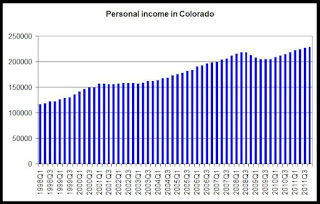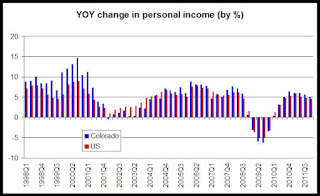As of the fourth quarter of 2011, Colorado's total personal income is 4.9 percent above peak levels achieved before the 2008 financial crisis. At $229.0 billion, personal income in Colorado is
above the peak levels reached during the second quarter of 2008, when
personal income reached $218.2 billion.
In
year-over-year comparisons, personal income in Colorado is also up 4.9
percent from the fourth quarter of 2010 to the same period of 2011.
This is the lowest year-over-year rate of increase since the second
quarter of 2010, when personal income grew 3.2 percent, year over year.
Personal
income in Colorado is now slightly further above peak levels than the
US as a whole. As of the 4th quarter of
2011,
the US is 4.6 percent above its own peak which occurred during the
second quarter of 2008.
Over ten years from the 4th
quarter of 2002 to the 4th quarter of 2011, US personal income increased
43.8 percent, and in Colorado it also increased 44.5 percent.
(personal income is shown in 1,000,000s)
Personal
income figures are not adjusted for inflation. Over the past decade,
the consumer price index in the United States West region increased 23
percent. So, income growth has outpaced inflation, but real income
growth is about half of nominal income growth.
Since
the peak levels reached during the fourth quarter of 2008, personal
income in Colorado is up 4.9 percent, but the CPI in the U.S. West has
increased 6.2 percent during the same period.
Much of
the increase that has occurred may be attributed to a 29 percent
increase in personal current transfer receipts since the 2008 peak.
The effect of personal current transfer receipts
An
important component of personal income is "personal current transfer
receipts." These are forms of income not died to wages and employment
income and include payments such as social security payments,
unemployment insurance, Medicare and Medicaid.
When personal current transfer receipts are removed from personal income, income growth is not as robust.
Without
the inclusion of transfer receipts, personal income in Colorado is only
up 1.8 percent from peak levels.
When
adjusted for inflation, personal income (minus transfer receipts) has actually
declined since 2008. Since the peak period, the CPI has increased 6.3
percent. Comparing the 1.8 percent increase in income since the peak
with the 6.3 percent increase in the CPI, we see that income growth has
not kept up with price inflation and that real incomes have not yet
returned to peak levels.
By this measure we find that
Colorado fares slightly better than the nation, however. With personal
current transfer receipts excluded, personal income nationwide has increased 1.7 percent.
Rates of change
The rate of increase in personal income for Colorado fell for four quarters in a row during 2011. With a post-recession peak of 6.3 percent in year-over-year growth during the fourth quarter of 2008, the rate of increase has fallen each quarter since, and was 4.9 percent during the fourth quarter of 2011.
The graph shows annual rates of change for personal income in Colorado and the US. Income growth has been considerably smaller in recent years than what was seen during the boom years of the late 1990s.
Personal income is the total amount of personal income received in the state from all sources. It should not be confused with per capita personal income.
Cool websites
- Casino Online Non Aams
- Siti Di Poker Online
- Casinos Not On Gamstop
- Gambling Sites Not On Gamstop
- Casinos Not On Gamstop
- Casino Non Aams Italia
- Casino Not On Gamstop
- Best Non Gamstop Casinos
- Sites Not On Gamstop
- Casino Sites Not On Gamstop
- Non Gamstop Casino
- Non-gamstop UK Casinos
- Non Gamstop Casino UK
- Sites Not On Gamstop
- Non Gamstop Casino
- Casino Non Aams
- Casino En Ligne Fiable
- Casino Not On Gamstop
- Non Gamstop Casinos
- Casinos Not On Gamstop
- UK Online Casinos Not On Gamstop
- Casino Online Non Aams
- Non Gamstop Casino Sites UK
- I Migliori Casino Online
- Casino Online Italia

